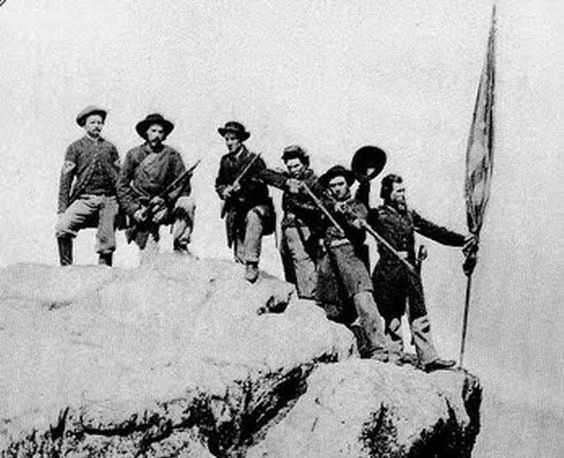Committed to Slavery and Union in 1863
Kentucky's Second Major Recruitment Surge

Eighth Kentucky Volunteer Infantry, Lookout Mountain, 1863
Brief Introduction
In 1863, the Emancipation Proclamation and black recruitment came into effect. Meant to impact the states in open rebellion, it proved to have a profound impact on loyal Kentuckians. During this year, Kentucky enjoyed its second highest recruitment surge. Despite the fact that Kentuckians abhorred abolition, these measures coincidently seemed to spur unionist sentiment. Hoping to protect the integrity of slavery by preventing the need of black recruitment, thousands of Kentuckians volunteered. Regardless of the factors which may have inhibited the state's recruitment in 1862, such as war weariness and guerrilla fighting, Kentucky managed to have a higher service record than either Michigan or Wisconsin. Considering the state's available manpower by the start of 1863, this recruitment surge is significant as it reveals that Kentucky's primary intent, to preserve slavery by using the Union as a catalyst, continued to motivate the state to furnish volunteers.
Historians have often contended that the Emancipation Proclamation and black recruitment hindered Kentucky's loyalty. However, as the state's recruitment data shows, this was not the case. The graphs below help to display that despite these measures and Kentucky's own manpower shortages, the state managed to recruit more troops than either Michigan or Wisconsin. Furthermore, Kentucky did not have to rely heavily on bounties or conscription which both Michigan and Wisconsin employed to help bolster their respective numbers. Michigan and Wisconsin also resorted to black recruitment almost as soon as it became federally permissible. This emphasizes that instead of hampering Kentucky's loyalty, emancipation and black recruitment helped motivate the state to commit some of its final reserves of white manpower for the preservation of slavery.
This data corresponds to the third chapter of my thesis.
Recruitment in 1863
This graph shows each state's relative recruitment record for 1863. Although at first glance it may appear that Kentucky's recruitment was not considerably different from Michigan's it is important to emphasize Michigan still failed to meet its quota. Although Kentucky fell slightly short of its quota, Michigan, and Wisconsin did not have the same excuses as Kentucky. Consequently, this signifies that despite having a smaller population, due to Confederate recruiting and the state militia, Kentucky still managed to furnish more troops. These troops represent some of Kentucky's final reserves of manpower and emphasize that the majority of the state was still committed to the federal war effort.
For a quick reference, Kentucky filled 94 percent of its quota while Michigan filled 69 percent and Wisconsin filled 44 percent.
Source: Adjutant General Reports
How these states filled their Quotas
What is perhaps most important about Kentucky's recruitment in 1863 was that it was solely made-up of white volunteers. Contrasting with Michigan and Wisconsin, Kentucky would not have to resort to conscription until 1864 when white enlistments could no longer meet federal requirements. Kentucky also did not have to rely heavily on bounties to entice enlistments. Unlike Michigan and Wisconsin, which relied heavily on federal, state, and local bounties to encourage enlistments, Kentucky generally only employed federal incentives. This graph signifies that Kentucky not only furnished more men than both Michigan and Wisconsin, but that they did so without having to draft men or offer significant financial compensation. It seems then that the desire to preserve the integrity of slavery, which black recruitment directly threatened, was the primary differentiator that encouraged Kentuckians to enlist in greater numbers than their northern counterparts.
Source: Adjutant General Reports
Proportional Service Record
Kentucky's Union recruitment record compared to Michigan and Wisconsin's. Despite having lost a sizeable portion of potential recruits to the Confederacy as well as to the state militia, Kentucky managed to keep pace with Michigan and Wisconsin. Despite Kentucky's reservations about the Emancipation Proclamation, the introduction of black recruitment, and its concerns regarding abolition, the state still believed that the laws of the Constitution guaranteed sovereignty and could protect slavery indefinitely. For that reason, white Kentuckians enlisted to both secure the future of slavery and maintain its integrity by filling its quota with white men instead of African Americans.
Source: Adjutant General Reports
Exhaustion: Available manpower by the end of 1863
By the end of 1863, Kentucky had considerably reduced its future recruitment capabilities. Owing to Union, Confederate, and Home Guard recruiting, the state had a remaining population that was 27 percent smaller than either Michigan or Wisconsin. Kentucky still had farms and businesses to maintain, as well as slaves to control (even though the Home Guard helped in this capacity), and could not continue its previous recruitment efforts indefinitely. Although able to maintain a comparable service record to these two northern states throughout the war, by the end of 1863, Kentucky had generally exhausted its white military-aged population. In 1864, the state attempted to further delay black recruitment by scrounging for as many white men as possible. This effort worked for a time but by early April 1864, black recruitment would commence in Kentucky.
Source: Adjutant General Reports